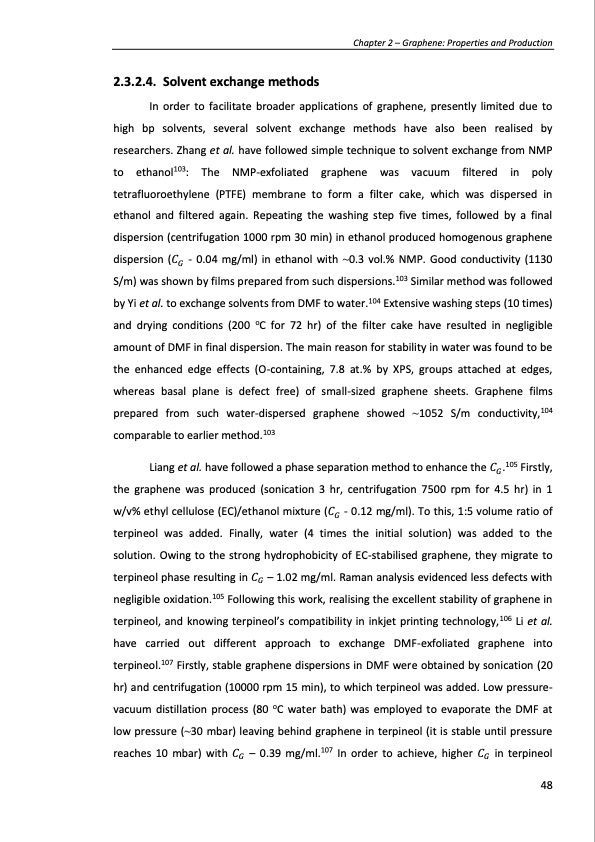
PDF Publication Title:
Text from PDF Page: 048
2.3.2.4. Solvent exchange methods In order to facilitate broader applications of graphene, presently limited due to high bp solvents, several solvent exchange methods have also been realised by researchers. Zhang et al. have followed simple technique to solvent exchange from NMP to ethanol103: The NMP-exfoliated graphene was vacuum filtered in poly tetrafluoroethylene (PTFE) membrane to form a filter cake, which was dispersed in ethanol and filtered again. Repeating the washing step five times, followed by a final dispersion (centrifugation 1000 rpm 30 min) in ethanol produced homogenous graphene dispersion (𝐶𝐺 - 0.04 mg/ml) in ethanol with ~0.3 vol.% NMP. Good conductivity (1130 S/m) was shown by films prepared from such dispersions.103 Similar method was followed by Yi et al. to exchange solvents from DMF to water.104 Extensive washing steps (10 times) and drying conditions (200 oC for 72 hr) of the filter cake have resulted in negligible amount of DMF in final dispersion. The main reason for stability in water was found to be the enhanced edge effects (O-containing, 7.8 at.% by XPS, groups attached at edges, whereas basal plane is defect free) of small-sized graphene sheets. Graphene films prepared from such water-dispersed graphene showed ~1052 S/m conductivity,104 comparable to earlier method.103 Liang et al. have followed a phase separation method to enhance the 𝐶𝐺 .105 Firstly, the graphene was produced (sonication 3 hr, centrifugation 7500 rpm for 4.5 hr) in 1 w/v% ethyl cellulose (EC)/ethanol mixture (𝐶𝐺 - 0.12 mg/ml). To this, 1:5 volume ratio of terpineol was added. Finally, water (4 times the initial solution) was added to the solution. Owing to the strong hydrophobicity of EC-stabilised graphene, they migrate to terpineol phase resulting in 𝐶𝐺 – 1.02 mg/ml. Raman analysis evidenced less defects with negligible oxidation.105 Following this work, realising the excellent stability of graphene in terpineol, and knowing terpineol’s compatibility in inkjet printing technology,106 Li et al. have carried out different approach to exchange DMF-exfoliated graphene into terpineol.107 Firstly, stable graphene dispersions in DMF were obtained by sonication (20 hr) and centrifugation (10000 rpm 15 min), to which terpineol was added. Low pressure- vacuum distillation process (80 oC water bath) was employed to evaporate the DMF at low pressure (~30 mbar) leaving behind graphene in terpineol (it is stable until pressure reaches 10 mbar) with 𝐶𝐺 – 0.39 mg/ml.107 In order to achieve, higher 𝐶𝐺 in terpineol Chapter 2 – Graphene: Properties and Production 48PDF Image | PRODUCTION AND APPLICATIONS OF GRAPHENE AND ITS COMPOSITES

PDF Search Title:
PRODUCTION AND APPLICATIONS OF GRAPHENE AND ITS COMPOSITESOriginal File Name Searched:
graphene-production-applications.PDFDIY PDF Search: Google It | Yahoo | Bing
Salgenx Redox Flow Battery Technology: Power up your energy storage game with Salgenx Salt Water Battery. With its advanced technology, the flow battery provides reliable, scalable, and sustainable energy storage for utility-scale projects. Upgrade to a Salgenx flow battery today and take control of your energy future.
| CONTACT TEL: 608-238-6001 Email: greg@infinityturbine.com | RSS | AMP |